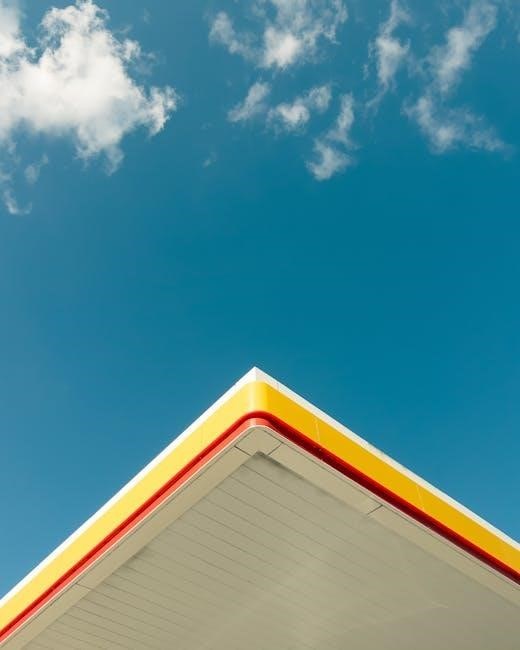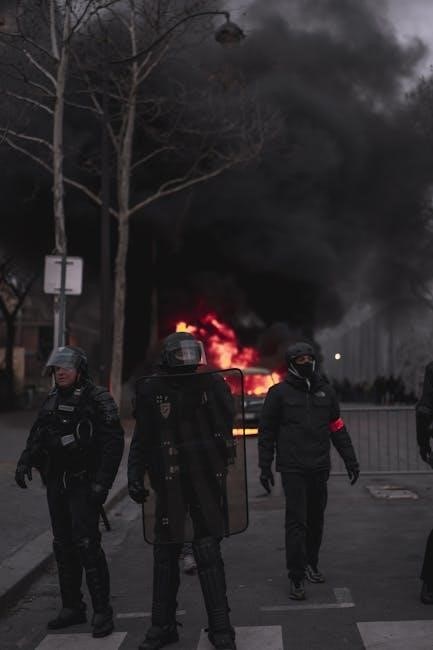Gas laws govern the behavior of gases‚ relating pressure‚ volume‚ and temperature. They are fundamental in chemistry and physics‚ essential for solving problems and understanding gas properties.
1.1 Overview of Gas Laws
Gas laws are fundamental principles describing the behavior of gases under varying conditions of pressure‚ volume‚ and temperature. These laws‚ including Boyle’s‚ Charles’s‚ and the ideal gas law‚ provide a framework for predicting gas behavior in different environments. Based on the ideal gas model‚ they assume gases consist of point particles with no intermolecular forces‚ simplifying calculations and applications in chemistry‚ physics‚ and engineering. Understanding these laws is essential for solving problems and designing systems involving gases across various scientific domains.
1.2 Importance of Gas Laws in Chemistry and Physics
Gas laws are foundational in chemistry and physics‚ providing essential insights into the behavior of gases. They are crucial for understanding chemical reactions‚ atmospheric phenomena‚ and industrial processes. These principles enable accurate predictions of pressure‚ volume‚ and temperature changes‚ which are vital in engineering‚ environmental science‚ and materials science. Mastery of gas laws is essential for solving real-world problems‚ from respiratory medicine to aerospace engineering‚ making them a cornerstone of both theoretical and applied sciences.
Key Gas Laws
Key gas laws include Boyle’s Law‚ Charles’s Law‚ Gay-Lussac’s Law‚ Combined Gas Law‚ and Ideal Gas Law‚ each describing specific relationships between pressure‚ volume‚ and temperature.
2.1 Boyle’s Law
Boyle’s Law states that for a fixed amount of gas at constant temperature‚ the pressure is inversely proportional to the volume. This means that as pressure increases‚ volume decreases‚ and vice versa. Mathematically‚ it is expressed as ( P_1V_1 = P_2V_2 )‚ where ( P ) represents pressure and ( V ) represents volume. Boyle’s Law is a foundational concept in understanding gas behavior and is widely applied in physics‚ chemistry‚ and engineering. It is particularly useful in scenarios involving gases at constant temperature‚ such as in scuba diving and pneumatic systems.
2.2 Charles’s Law
Charles’s Law describes the direct relationship between the volume and temperature of a gas at constant pressure. It states that as temperature increases‚ the volume of the gas also increases proportionally. The law is mathematically expressed as ( rac{V_1}{T_1} = rac{V_2}{T_2} )‚ where ( V ) is volume and ( T ) is temperature in Kelvin. This principle is crucial in understanding thermal expansion and is widely applied in fields such as chemistry‚ physics‚ and engineering. It is a cornerstone for predicting gas behavior under varying thermal conditions.
2.3 Gay-Lussac’s Law
Gay-Lussac’s Law states that the pressure of a gas is directly proportional to its temperature when volume is held constant. Mathematically‚ it is expressed as ( rac{P_1}{T_1} = rac{P_2}{T_2} )‚ where ( P ) is pressure and ( T ) is temperature in Kelvin. This law is vital in understanding how gases respond to thermal changes and is often combined with other gas laws to solve complex problems. Its applications are seen in fields like chemistry‚ physics‚ and engineering‚ providing insights into gas behavior under varying conditions.
2.4 Combined Gas Law
The Combined Gas Law integrates Boyle’s‚ Charles’s‚ and Gay-Lussac’s laws‚ describing how pressure‚ volume‚ and temperature of a gas change simultaneously. Expressed as ( P_1V_1/T_1 = P_2V_2/T_2 )‚ it allows calculation of one variable when others are known. This law is crucial for solving problems involving changes in all three gas properties and is widely applied in scientific and engineering scenarios‚ providing a comprehensive understanding of gas behavior under varying conditions and simplifying complex calculations into a single formula.
2.5 Ideal Gas Law
The Ideal Gas Law‚ PV = nRT‚ describes the behavior of ideal gases‚ where P is pressure‚ V is volume‚ n is moles‚ R is the gas constant‚ and T is temperature. This law assumes no intermolecular forces and negligible molecular volume‚ simplifying calculations. Derived from the Combined Gas Law‚ it applies to ideal conditions and is widely used in chemistry and physics to solve problems involving gas properties. Its universality makes it a fundamental tool for understanding and predicting gas behavior under various conditions‚ though real gases may deviate slightly from its predictions.

Gas Laws Equations and Formulas
Gas laws equations‚ such as Boyle’s‚ Charles’s‚ and the Ideal Gas Law‚ relate pressure‚ volume‚ and temperature. These formulas are essential for solving gas-related problems.
3.1 Derivation of Gas Law Equations
The derivation of gas law equations begins with empirical observations. Boyle’s Law‚ relating pressure and volume‚ was derived from experiments with a fixed amount of gas at constant temperature. Similarly‚ Charles’s Law‚ linking volume and temperature‚ emerged from studies under constant pressure. These individual laws were later combined into the Combined Gas Law. The Ideal Gas Law‚ derived by incorporating Avogadro’s principle‚ provides a comprehensive relationship between pressure‚ volume‚ temperature‚ and moles of gas. These derivations form the foundation for solving various gas-related problems in chemistry and physics.
3.2 Key Variables in Gas Law Equations (P‚ V‚ T‚ n‚ R)
The key variables in gas law equations are pressure (P)‚ volume (V)‚ temperature (T)‚ moles of gas (n)‚ and the gas constant (R). Pressure and volume are inversely related at constant temperature‚ while volume and temperature are directly proportional at constant pressure. Moles of gas represent the amount of substance‚ and R is a universal constant. These variables are essential for calculations involving the Ideal Gas Law (PV = nRT) and other gas-related problems. Understanding their relationships is critical for solving both theoretical and practical gas law questions.
3.3 Units and Conversions in Gas Law Calculations
Consistent units are crucial in gas law calculations. Pressure (P) is often in atmospheres (atm)‚ pascals (Pa)‚ or mmHg. Volume (V) is typically in liters (L) or cubic meters (m³). Temperature (T) must be in Kelvin (K). Moles (n) are unitless. The gas constant (R) varies with units‚ e.g.‚ 0.0821 L·atm/mol·K or 8.314 J/mol·K. Conversions‚ like 1 atm = 760 mmHg or 101325 Pa‚ ensure accuracy. Proper unit handling avoids calculation errors‚ making it essential to align units with the gas law being applied.

Common Gas Law Problems and Solutions
This section covers common gas law problems and practical solutions‚ including pressure‚ volume‚ and temperature calculations‚ as well as various real-world applications of gas principles.
4.1 Calculating Pressure‚ Volume‚ and Temperature
This section focuses on solving problems involving gas law calculations‚ such as determining pressure‚ volume‚ or temperature changes. Using Boyle’s‚ Charles’s‚ and the ideal gas law‚ students can find unknown variables in gas systems. Common problems include calculating moles of gas‚ volume at standard temperature and pressure‚ or pressure changes with temperature. These calculations often involve rearranging gas law formulas like PV = nRT to isolate the desired variable. Real-world applications‚ such as scuba diving and gas storage‚ demonstrate the practical importance of these calculations.
4.2 Moles of Gas and Avogadro’s Law
Avogadro’s Law states that the volume of a gas is directly proportional to the number of moles at constant temperature and pressure. This law is crucial for calculating the moles of gas in various scenarios. Common problems involve finding the number of moles using the ideal gas law (PV = nRT) or determining volume changes when moles are added or removed; These calculations are essential for understanding chemical reactions and stoichiometry‚ where precise mole ratios are critical. Practice questions often involve real-world applications‚ such as gas mixtures and reactions at standard conditions.
4.3 Real-World Applications of Gas Laws
Gas laws are essential in various real-world applications‚ such as medical devices‚ scuba diving‚ and industrial processes. For instance‚ anesthesia machines rely on gas laws to regulate pressure and volume for safe patient use. In automotive engineering‚ gas laws help design efficient engines and airbags. Environmental monitoring also uses these principles to analyze air quality and greenhouse gas effects. Understanding gas laws enables precise calculations in everyday technologies‚ ensuring safety and efficiency in industrial and medical settings.

Gas Laws Multiple Choice Questions
Test your understanding with multiple-choice questions covering fundamental gas law concepts‚ pressure-volume relationships‚ and ideal gas behavior. Identify knowledge gaps and strengthen problem-solving skills effectively.
5.1 Basic Gas Law Concepts
Explore fundamental gas law principles through multiple-choice questions. Test understanding of pressure-volume-temperature relationships‚ ideal gas behavior‚ and core equations. Questions cover basic concepts like Boyle’s‚ Charles’s‚ and Gay-Lussac’s laws‚ ensuring a solid grasp of foundational principles. Topics include identifying gas properties‚ understanding gas constants‚ and applying basic formulas. These questions help reinforce key concepts and prepare for more complex problem-solving. Ideal for students seeking to master the essentials of gas laws and their practical applications in chemistry and physics.
5.2 Intermediate Gas Law Problems
Engage with challenging questions that test your ability to apply gas laws in complex scenarios. These problems involve calculating unknown variables like pressure‚ volume‚ and temperature under varying conditions. Examples include determining the pressure of a gas mixture‚ finding the unknown temperature after volume changes‚ and solving for moles of gas using Avogadro’s Law. Questions also address real-world applications‚ such as gas behavior at high pressures or low temperatures. These exercises help bridge the gap between basic concepts and advanced problem-solving‚ ensuring a deeper understanding of gas law principles and their practical implications.
5.3 Advanced Gas Law Scenarios
Explore advanced gas law problems that involve complex‚ real-world scenarios‚ such as multi-step calculations and non-ideal gas behavior. These questions challenge your understanding of gas laws in dynamic conditions‚ such as varying temperatures‚ pressures‚ and volumes. Examples include analyzing gas mixtures‚ calculating molar concentrations‚ and solving for unknown variables in industrial processes. These scenarios require critical thinking and the ability to apply multiple gas laws simultaneously‚ preparing you for practical applications in fields like engineering and chemistry. Detailed solutions guide you through intricate problem-solving techniques.

Gas Laws True/False and Fill-in-the-Blank Questions
Test your understanding with true/false questions and fill-in-the-blank exercises‚ reinforcing key concepts like Boyle’s Law‚ Charles’s Law‚ and the Ideal Gas Law definitions and applications.
6.1 Key Concepts in Gas Laws
Key concepts in gas laws include understanding the relationships between pressure‚ volume‚ and temperature. Boyle’s Law describes pressure-volume relationships at constant temperature‚ while Charles’s Law explores volume-temperature relationships at constant pressure. The Ideal Gas Law integrates these variables through the equation PV = nRT. Avogadro’s Law highlights the role of moles of gas; These principles form the foundation for solving problems and analyzing gas behavior under various conditions. True/false and fill-in-the-blank questions test comprehension of these core ideas‚ ensuring a solid grasp of gas laws and their applications.
6.2 Gas Law Equations and Their Applications
Gas law equations are essential tools for solving problems involving gases. Boyle’s Law (P1V1 = P2V2)‚ Charles’s Law (V1/T1 = V2/T2)‚ and the Combined Gas Law (P1V1/T1 = P2V2/T2) are fundamental. The Ideal Gas Law (PV = nRT) relates pressure‚ volume‚ temperature‚ and moles of gas. These equations are applied in various fields‚ including chemistry‚ physics‚ and engineering‚ to calculate unknown variables like pressure‚ volume‚ or temperature. Understanding their derivations and applications is crucial for mastering gas law problems and real-world scenarios.

Gas Laws Essay Questions
Essay questions explore historical developments‚ practical implications‚ and real-world applications of gas laws‚ challenging students to synthesize knowledge and apply concepts critically.
7.1 Historical Development of Gas Laws
The historical development of gas laws began with early scientists like Boyle‚ Charles‚ and Gay-Lussac‚ who explored the relationships between pressure‚ volume‚ and temperature. Boyle’s Law‚ Charles’s Law‚ and Gay-Lussac’s Law laid the foundation for understanding gas behavior. These pioneers conducted experiments that revealed how gases respond to changes in external conditions. Their work culminated in the Ideal Gas Law‚ which unified their findings. This historical progression not only shaped modern chemistry and physics but also revolutionized industrial and scientific applications‚ making gas laws indispensable in various fields today.
7.2 Practical Implications of Gas Laws in Science and Engineering
Gas laws have profound practical implications in science and engineering‚ enabling the design of systems like internal combustion engines and air conditioning. They are crucial in chemical processing‚ where precise control of pressure‚ volume‚ and temperature ensures efficient reactions. In aerospace engineering‚ understanding gas behavior is vital for propulsion systems and atmospheric re-entry simulations. Medical applications include respirators and anesthetic delivery systems. These laws also guide environmental studies‚ such as atmospheric modeling and greenhouse gas analysis. Their universal applicability makes gas laws indispensable in modern technological advancements and problem-solving across diverse disciplines.
Gas Laws Case Studies
Gas laws case studies provide real-world examples of their applications‚ offering insights into industrial and medical uses. These practical scenarios help students and professionals understand complex gas behavior.
8.1 Industrial Applications of Gas Laws
Gas laws are integral to various industrial processes‚ ensuring safety and efficiency. In manufacturing‚ they guide pressure and volume control in reactors and storage tanks.
- Chemical plants use gas laws to optimize reactions and manage hazardous gases.
- In energy production‚ gas laws aid in reservoir analysis and fuel transport.
- Industrial safety relies on understanding gas behavior under extreme conditions.
These applications highlight the practical importance of gas laws in modern industry‚ enabling precise calculations and informed decision-making.
8.2 Medical Applications of Gas Laws
Gas laws play a crucial role in medical fields‚ particularly in respiratory care and anesthesia. They help calculate oxygen delivery and anesthesia gas mixtures for patients.
- Medical ventilators rely on gas laws to regulate airflow and pressure.
- Anesthesia machines use these principles to maintain safe gas concentrations.
- Gas laws also aid in hyperbaric medicine for treating decompression sickness.
Understanding gas behavior ensures precise treatment delivery‚ enhancing patient safety and care outcomes in medical settings.

Gas Laws Experimental Verification
Experiments confirm gas laws through controlled measurements of pressure‚ volume‚ and temperature changes‚ validating theoretical predictions and their real-world applications in physics and chemistry.
9.1 Laboratory Experiments to Demonstrate Gas Laws
Laboratory experiments are essential for validating gas laws. One common setup involves measuring pressure and volume changes in a sealed syringe or cylinder. By controlling variables like temperature‚ students can observe how pressure and volume relationships align with Boyle’s Law. Similarly‚ experiments with gas-filled balloons or cylinders at varying temperatures demonstrate Charles’s Law. These hands-on activities provide practical insights into theoretical concepts‚ allowing students to collect data‚ analyze results‚ and draw conclusions about gas behavior under different conditions.
9.2 Data Analysis and Interpretation in Gas Law Experiments
Data analysis in gas law experiments involves interpreting measurements of pressure‚ volume‚ and temperature. Graphical methods‚ such as plotting pressure vs. volume or temperature vs. volume‚ help visualize relationships. Calculations using gas law equations confirm theoretical predictions. Sources of error‚ like instrument limitations or human factors‚ are identified and discussed. Comparing experimental results with ideal gas law constants validates the accuracy of findings. This process enhances understanding of gas behavior and reinforces key concepts through hands-on learning and critical evaluation.

Gas Laws Review and Practice
Regular practice and review of gas law problems enhance understanding and problem-solving skills. Mixed exercises and tips help identify common mistakes and improve accuracy in calculations;
10.1 Mixed Gas Law Problems
Mixed gas law problems require applying multiple principles‚ such as Boyle’s‚ Charles’s‚ and the Ideal Gas Law‚ to solve for unknown variables. These problems often involve changes in pressure‚ volume‚ or temperature while relating moles of gas. Practicing these scenarios enhances critical thinking and the ability to approach complex calculations systematically. Key strategies include identifying known and unknown variables‚ selecting the appropriate law‚ and ensuring unit consistency. Solving mixed problems not only reinforces understanding but also prepares students for real-world applications in chemistry and physics.
10.2 Common Mistakes in Gas Law Calculations
Common errors in gas law calculations often stem from unit mismatches and incorrect formula applications. For instance‚ using Celsius instead of Kelvin for temperature or failing to convert pressure units can lead to inaccuracies. Misapplying the ideal gas law by omitting the gas constant or confusing pressure and volume ratios is another frequent mistake. Additionally‚ neglecting to consider the number of moles or assuming ideal behavior in real-world scenarios can skew results. Awareness of these pitfalls helps improve accuracy and mastery in solving gas law problems.
10.3 Tips for Mastering Gas Law Questions
Mastering gas law questions requires consistent practice and a deep understanding of underlying concepts. Start by thoroughly reviewing gas law equations and their derivations. Practice solving problems systematically‚ ensuring unit consistency and proper formula application. Begin with simple problems and gradually tackle more complex scenarios. Use diagrams and charts to visualize relationships between variables. Additionally‚ analyze common mistakes and learn from them. Regularly test yourself with mixed-problem sets to build confidence and fluency. Stay persistent and confident in your problem-solving abilities.
Gas laws are foundational in understanding gas behavior‚ essential for chemistry and physics. This guide provides comprehensive questions and answers to enhance learning and problem-solving skills.
11.1 Summary of Key Concepts
Gas laws are fundamental principles that describe the behavior of gases under various conditions. Boyle’s‚ Charles’s‚ and Gay-Lussac’s laws form the foundation‚ while the Combined Gas Law and Ideal Gas Law integrate these relationships. Understanding these concepts is crucial for solving problems involving pressure‚ volume‚ temperature‚ and moles of gas. Practical applications in chemistry‚ physics‚ and engineering highlight their relevance. Mastering gas laws requires a strong grasp of equations‚ variables‚ and units‚ enabling accurate calculations and real-world problem-solving. Practice with diverse questions and scenarios is essential for proficiency.
11.2 Final Thoughts on Gas Laws
Gas laws are foundational principles that govern the behavior of gases‚ essential for understanding their properties and interactions. From Boyle’s Law to the Ideal Gas Law‚ these concepts provide a framework for solving real-world problems in chemistry‚ physics‚ and engineering. Their applications span industrial processes‚ medical devices‚ and environmental studies‚ highlighting their universal importance. Continuous practice and problem-solving reinforce mastery‚ making gas laws a cornerstone of scientific literacy and innovation. Their relevance ensures they remain a vital area of study and application in modern science.
